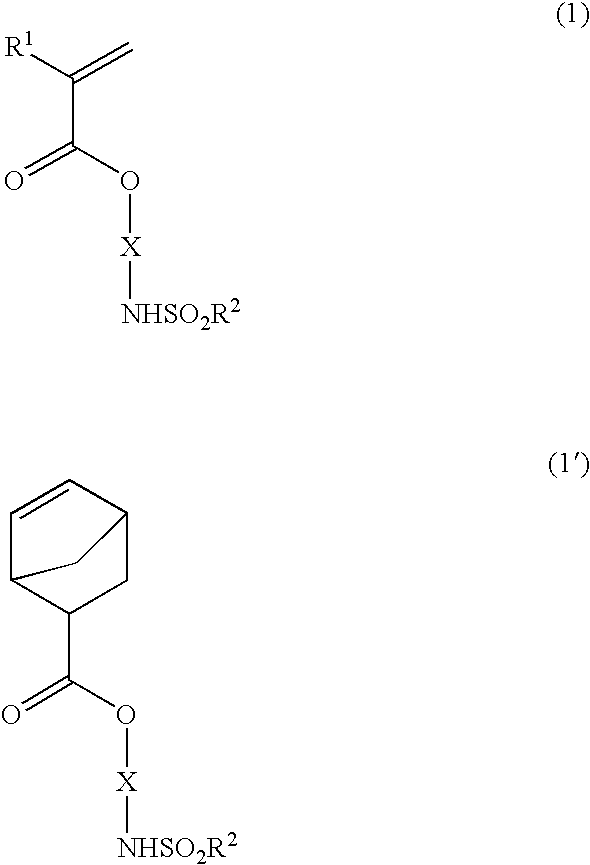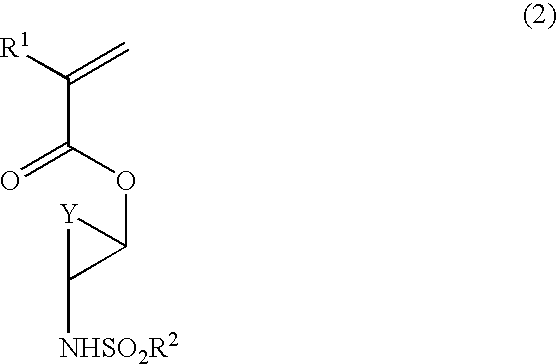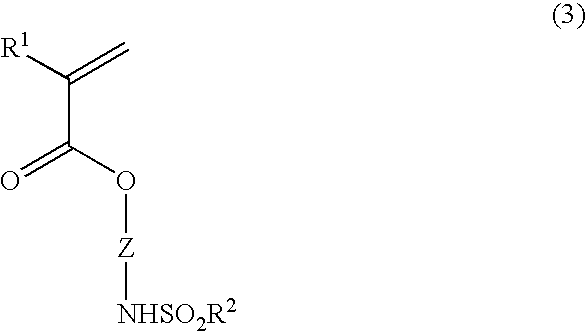Polymerizable ester having sulfonamide structure, polymer, resist composition and patterning process
a technology of polymer and ester, which is applied in the direction of photosensitive materials, instruments, photomechanical equipment, etc., can solve the problems of not being able to meet the requirements of resist materials, not being able to meet the requirements of practically acceptable resist materials, and all resins are unsatisfactory
- Summary
- Abstract
- Description
- Claims
- Application Information
AI Technical Summary
Benefits of technology
Problems solved by technology
Method used
Image
Examples
first embodiment
the invention is directed to a polymerizable ester compound having the general formula (1) or (1′).
Herein R1 is hydrogen, methyl or trifluoromethyl, R2 is a straight, branched or cyclic C1-C10 alkyl group in which some or all of the hydrogen atoms may be substituted with halogen atoms, and X is a divalent saturated hydrocarbon group having an alicyclic structure.
In formula (1), R1 is hydrogen, methyl or trifluoromethyl. In the event R1=trifluoromethyl, the corresponding polymer has a high transparency at the wavelength of 157 nm as well and is thus applicable to the F2 excimer laser resist.
In formulae (1) and (1′), R2 is a straight, branched or cyclic C1-C10 alkyl group in which some or all of the hydrogen atoms may be substituted with halogen atoms. Examples of suitable alkyl groups represented by R2 include methyl, ethyl, propyl, 2-propyl, butyl, 2-butyl, isobutyl, t-butyl, pentyl, hexyl, cyclohexyl, decyl, trichloromethyl, trifluoromethyl, pentafluoroethyl, nonafluorobutyl a...
example 1
Synthesis of 2-[(methylsulfonyl)amino]cyclohexyl methacrylate
In a nitrogen atmosphere, a mixture of 108 g of 1,2-epoxycyclohexane, 95.1 g of methanesulfonamide, 11.2 g of t-butoxypotassium, and 1,000 g of tetrahydrofuran was heated under reflux for 100 hours. The reaction solution was neutralized with hydrochloric acid and then subjected to conventional aqueous work-up. Purification by column chromatography yielded an alcohol compound, 2-[(methylsulfonyl)amino]cyclohexanol. In a nitrogen atmosphere, the alcohol compound was combined with 111 g of triethylamine and 2,000 g of acetonitrile, to which 105 g of methacryloyl chloride was added dropwise at −20° C. The mixture was gradually warmed to room temperature and then stirred for 10 hours. The reaction mixture was subjected to conventional aqueous work-up and purified by column chromatography, obtaining 165 g of 2-[(methylsulfonyl)amino]-cyclohexyl methacrylate. The yield was 63% based on the methanesulfonamide.
IR & NMR Analys...
example 2
Synthesis of 2-[(methylsulfonyl)amino]cyclohexyl acrylate
By following the same procedure as in Example 1 except that an equimolar amount of acryloyl chloride was used instead of the methacryloyl chloride, 2-[(methylsulfonyl)-amino]cyclohexyl acrylate was synthesized (yield 60%).
PUM
| Property | Measurement | Unit |
|---|---|---|
| Fraction | aaaaa | aaaaa |
| Nanoscale particle size | aaaaa | aaaaa |
| Transparency | aaaaa | aaaaa |
Abstract
Description
Claims
Application Information
 Login to View More
Login to View More - R&D
- Intellectual Property
- Life Sciences
- Materials
- Tech Scout
- Unparalleled Data Quality
- Higher Quality Content
- 60% Fewer Hallucinations
Browse by: Latest US Patents, China's latest patents, Technical Efficacy Thesaurus, Application Domain, Technology Topic, Popular Technical Reports.
© 2025 PatSnap. All rights reserved.Legal|Privacy policy|Modern Slavery Act Transparency Statement|Sitemap|About US| Contact US: help@patsnap.com



